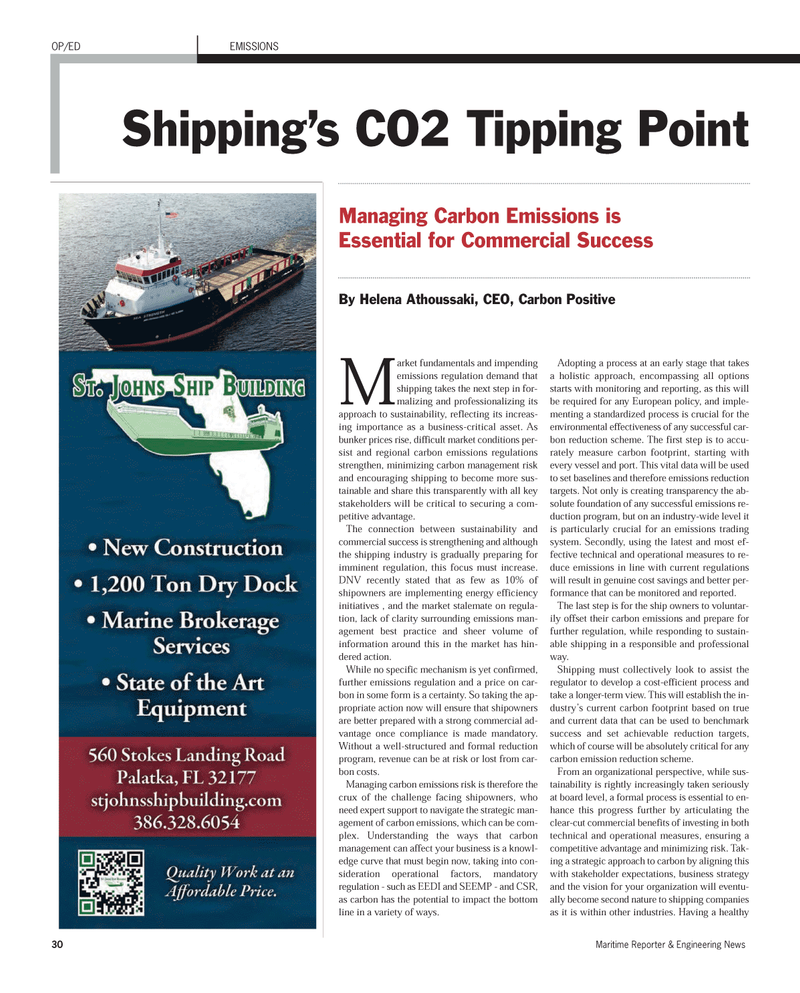
Page 30: of Maritime Reporter Magazine (June 2012)
Annual World Yearbook
Read this page in Pdf, Flash or Html5 edition of June 2012 Maritime Reporter Magazine
30Maritime Reporter & Engineering News Market fundamentals and impending emissions regulation demand that shipping takes the next step in for- malizing and professionalizing itsapproach to sustainability, reflecting its increas- ing importance as a business-critical asset. As bunker prices rise, difficult market conditions per- sist and regional carbon emissions regulations strengthen, minimizing carbon management riskand encouraging shipping to become more sus-tainable and share this transparently with all key stakeholders will be critical to securing a com- petitive advantage. The connection between sustainability andcommercial success is strengthening and althoughthe shipping industry is gradually preparing forimminent regulation, this focus must increase. DNV recently stated that as few as 10% of shipowners are implementing energy efficiency initiatives , and the market stalemate on regula- tion, lack of clarity surrounding emissions man-agement best practice and sheer volume of information around this in the market has hin- dered action.While no specific mechanism is yet confirmed, further emissions regulation and a price on car- bon in some form is a certainty. So taking the ap- propriate action now will ensure that shipowners are better prepared with a strong commercial ad-vantage once compliance is made mandatory. Without a well-structured and formal reduction program, revenue can be at risk or lost from car- bon costs.Managing carbon emissions risk is therefore thecrux of the challenge facing shipowners, who need expert support to navigate the strategic man- agement of carbon emissions, which can be com-plex. Understanding the ways that carbon management can affect your business is a knowl- edge curve that must begin now, taking into con- sideration operational factors, mandatory regulation - such as EEDI and SEEMP - and CSR, as carbon has the potential to impact the bottomline in a variety of ways. Adopting a process at an early stage that takes a holistic approach, encompassing all optionsstarts with monitoring and reporting, as this willbe required for any European policy, and imple- menting a standardized process is crucial for theenvironmental effectiveness of any successful car- bon reduction scheme. The first step is to accu- rately measure carbon footprint, starting withevery vessel and port. This vital data will be used to set baselines and therefore emissions reductiontargets. Not only is creating transparency the ab- solute foundation of any successful emissions re- duction program, but on an industry-wide level it is particularly crucial for an emissions tradingsystem. Secondly, using the latest and most ef- fective technical and operational measures to re- duce emissions in line with current regulations will result in genuine cost savings and better per- formance that can be monitored and reported. The last step is for the ship owners to voluntar- ily offset their carbon emissions and prepare for further regulation, while responding to sustain- able shipping in a responsible and professionalway. Shipping must collectively look to assist the regulator to develop a cost-efficient process and take a longer-term view. This will establish the in- dustry?s current carbon footprint based on true and current data that can be used to benchmarksuccess and set achievable reduction targets, which of course will be absolutely critical for any carbon emission reduction scheme.From an organizational perspective, while sus- tainability is rightly increasingly taken seriously at board level, a formal process is essential to en- hance this progress further by articulating theclear-cut commercial benefits of investing in both technical and operational measures, ensuring acompetitive advantage and minimizing risk. Tak- ing a strategic approach to carbon by aligning this with stakeholder expectations, business strategy and the vision for your organization will eventu- ally become second nature to shipping companiesas it is within other industries. Having a healthy OP/EDEMISSIONSShipping?s CO2 Tipping Point Managing Carbon Emissions is Essential for Commercial Success By Helena Athoussaki, CEO, Carbon PositiveMR June12 # 4 (25-33):MR Template 6/13/2012 9:26 AM Page 30

 29
29

 31
31
